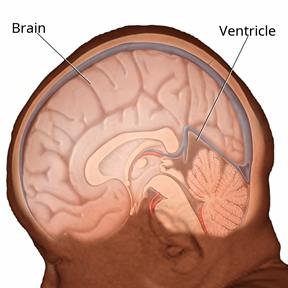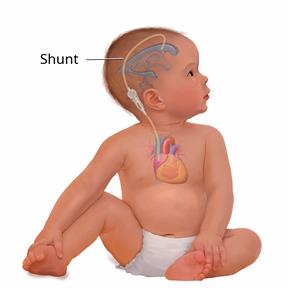Fluid in the Brain (Hydrocephalus) in Children: What to Know

Hydrocephalus is a condition where there is too much fluid called cerebrospinal fluid (CSF) in the brain. A child can be born with hydrocephalus or develop it during or after birth.
The brain makes CSF, which fills up spaces inside the brain called ventricles to protect and nourish the brain and spinal cord. With hydrocephalus, CSF does not drain correctly from the brain, and it builds up. This build-up of fluid can cause brain tissue and cell damage.
What are the causes?
The most common cause of hydrocephalus is a blockage between two ventricles that prevents CSF from moving through the brain. Problems can happen before the baby is born, such as:- The spinal cord not forming correctly.
- The brain not forming correctly.
- Brain cysts.
- Infections in the mother changing how the baby grows.
- Problems with the baby's genes.
- Bleeding in the brain, which can happen if the baby is born too early.
- Head injury.
- Brain tumors.
- Brain infections, like meningitis.
- Lack of oxygen to the brain.
What increases the risk?
Your child is more likely to have hydrocephalus if:- There is a family history of it. This is the most important risk factor.
- The child's mother received poor care before giving birth.
- The child is a twin or other multiple.
- The child's mother had diabetes during pregnancy.
- Being born too soon or having a low birth weight.
- Having head injuries.
- Having any of these:
- Brain tumors.
- A stroke.
- Bleeding or blood clots inside the brain.
- Brain infections.
- Being male.
What are the signs or symptoms?
Symptoms of hydrocephalus in babies may include:- Rapid increase in head size.
- Bulging of the soft spot, called the fontanel, on a baby's head.
- Sleepiness or irritability.
- Throwing up.
- Downward-gazing eyes.
- Seizures.
- Headache.
- Feeling like they may throw up and throwing up.
- Clumsiness.
- Downward-gazing eyes, blurred vision, or double vision.
- Sleepiness and irritability.
- Problems controlling poop or pee.
- Personality changes and memory problems.
How is this diagnosed?
Hydrocephalus may be diagnosed by:- Medical history and physical exam.
- Brain imaging tests, including a CT scan and MRI.
Sometimes, this is diagnosed before birth. This may happen if the mother has a imaging test called a fetal ultrasound during pregnancy.
How is this treated?
 Surgery is the only treatment for hydrocephalus. Surgery may involve:
Surgery is the only treatment for hydrocephalus. Surgery may involve:- Placing a flexible tube in the brain or spinal cord to drain the fluid into another part of the body. This is called a shunt.
- The shunt may need to be adjusted or replaced over time as your child grows.
- Having a thin, flexible tube with a camera moved into a ventricle. The surgeon then makes a hole in the floor of the ventricle to drain CSF.
- A device used to lightly burn, or cauterize, the blood vessels in the area where CSF is made in order to reduce the amount of CSF that is made.
Follow these instructions at home:
-
Learn as much as you can about your child's condition, and work closely with all of your child's health care providers.
-
Ask your child's provider if your child can safely participate in sports.
-
Have your child wear head protection when doing any activities that may cause head injury, such as biking or skating. Talk to your child's provider about head protection.
-
Keep all follow-up visits. Your child will be monitored to make sure CSF is draining from the brain correctly.
Where to find more information
-
The Hydrocephalus Association: hydroassoc.org
-
National Hydrocephalus Foundation: nhfonline.org
Contact a health care provider if:
-
Your child has chills or a fever.
-
Your child has changes in symptoms or new symptoms.
-
Your child becomes more sleepy or irritable.
-
Your child has a lack of appetite.
Get help right away if:
-
Your child has trouble breathing.
-
Your child has a seizure.
-
Your child has a very bad headache or stiff neck.
-
Your child has vision changes.
-
Your child can't stop throwing up.
-
Your child is hard to wake up.
-
Your child has an enlarged head or a bulging fontanel.
These symptoms may be an emergency. Do not wait to see if the symptoms will go away. Call 911 right away.
This information is not intended to replace advice given to you by your health care provider. Make sure you discuss any questions you have with your health care provider.

